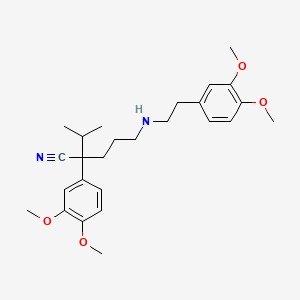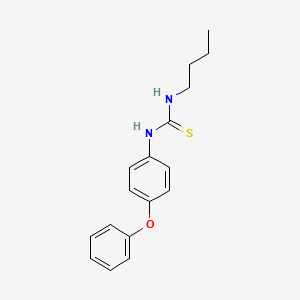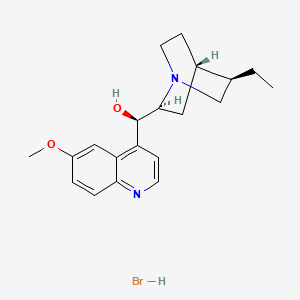
Norverapamil
Overview
Description
Norverapamil is a calcium channel blocker and the primary active metabolite of verapamil. It is known for its significant role in cardiovascular treatments, particularly in managing conditions such as hypertension, angina, and certain types of arrhythmias . The compound’s chemical formula is C26H36N2O4, and it has a molar mass of 440.58 g/mol .
Scientific Research Applications
Norverapamil has a wide range of scientific research applications:
Chemistry: Used as a model compound in studies of calcium channel blockers and their interactions with other molecules.
Biology: Studied for its effects on cellular calcium channels and its role in cellular signaling pathways.
Medicine: Investigated for its therapeutic potential in treating cardiovascular diseases, including hypertension and arrhythmias. It is also studied for its potential use in treating other conditions such as migraines and certain types of cancer.
Industry: Used in the development of new pharmaceuticals and as a reference compound in quality control processes
Mechanism of Action
Safety and Hazards
Norverapamil is harmful if swallowed and can cause skin and eye irritation. It may also cause respiratory irritation. It is highly flammable . It may cause anemia, cough, CNS depression, drowsiness, headache, heart damage, lassitude (weakness, exhaustion), liver damage, narcosis, reproductive effects, and teratogenic effects .
Preparation Methods
Synthetic Routes and Reaction Conditions: The synthesis of norverapamil typically involves the demethylation of verapamil. One common method includes reacting verapamil with 1-chloroethyl chloroformate in an aprotic solvent. The reaction is carried out at temperatures ranging from 10°C to 80°C, resulting in the formation of a quaternary ammonium salt. This intermediate is then subjected to further reaction to remove the methyl group, yielding this compound .
Industrial Production Methods: Industrial production of this compound follows similar synthetic routes but on a larger scale. The process is optimized for high conversion rates and ease of separation. The use of cost-effective raw materials and controlled reaction conditions ensures efficient production .
Chemical Reactions Analysis
Types of Reactions: Norverapamil undergoes various chemical reactions, including:
Reduction: Involves the removal of oxygen or the addition of hydrogen, typically using reducing agents.
Substitution: Involves the replacement of one functional group with another, often using nucleophiles or electrophiles.
Common Reagents and Conditions:
Oxidation: Common oxidizing agents include potassium permanganate and chromium trioxide.
Reduction: Common reducing agents include lithium aluminum hydride and sodium borohydride.
Substitution: Common reagents include halogens and alkylating agents.
Major Products: The major products formed from these reactions depend on the specific conditions and reagents used. For example, oxidation may yield hydroxylated derivatives, while reduction may produce deoxygenated compounds .
Comparison with Similar Compounds
Verapamil: The parent compound of norverapamil, also a calcium channel blocker with similar therapeutic uses.
Diltiazem: Another calcium channel blocker used to treat hypertension and angina.
Nifedipine: A dihydropyridine calcium channel blocker used primarily for hypertension.
Uniqueness of this compound: this compound is unique due to its specific metabolic origin from verapamil and its distinct pharmacokinetic properties. It has a longer half-life and different metabolic pathways compared to its parent compound, making it particularly effective in certain therapeutic contexts .
Properties
IUPAC Name |
2-(3,4-dimethoxyphenyl)-5-[2-(3,4-dimethoxyphenyl)ethylamino]-2-propan-2-ylpentanenitrile | |
|---|---|---|
| Source | PubChem | |
| URL | https://pubchem.ncbi.nlm.nih.gov | |
| Description | Data deposited in or computed by PubChem | |
InChI |
InChI=1S/C26H36N2O4/c1-19(2)26(18-27,21-9-11-23(30-4)25(17-21)32-6)13-7-14-28-15-12-20-8-10-22(29-3)24(16-20)31-5/h8-11,16-17,19,28H,7,12-15H2,1-6H3 | |
| Source | PubChem | |
| URL | https://pubchem.ncbi.nlm.nih.gov | |
| Description | Data deposited in or computed by PubChem | |
InChI Key |
UPKQNCPKPOLASS-UHFFFAOYSA-N | |
| Source | PubChem | |
| URL | https://pubchem.ncbi.nlm.nih.gov | |
| Description | Data deposited in or computed by PubChem | |
Canonical SMILES |
CC(C)C(CCCNCCC1=CC(=C(C=C1)OC)OC)(C#N)C2=CC(=C(C=C2)OC)OC | |
| Source | PubChem | |
| URL | https://pubchem.ncbi.nlm.nih.gov | |
| Description | Data deposited in or computed by PubChem | |
Molecular Formula |
C26H36N2O4 | |
| Source | PubChem | |
| URL | https://pubchem.ncbi.nlm.nih.gov | |
| Description | Data deposited in or computed by PubChem | |
Related CAS |
67812-42-4 (mono-hydrochloride) | |
| Record name | Norverapamil | |
| Source | ChemIDplus | |
| URL | https://pubchem.ncbi.nlm.nih.gov/substance/?source=chemidplus&sourceid=0067018853 | |
| Description | ChemIDplus is a free, web search system that provides access to the structure and nomenclature authority files used for the identification of chemical substances cited in National Library of Medicine (NLM) databases, including the TOXNET system. | |
DSSTOX Substance ID |
DTXSID80873799 | |
| Record name | Norverapamil | |
| Source | EPA DSSTox | |
| URL | https://comptox.epa.gov/dashboard/DTXSID80873799 | |
| Description | DSSTox provides a high quality public chemistry resource for supporting improved predictive toxicology. | |
Molecular Weight |
440.6 g/mol | |
| Source | PubChem | |
| URL | https://pubchem.ncbi.nlm.nih.gov | |
| Description | Data deposited in or computed by PubChem | |
CAS No. |
67018-85-3 | |
| Record name | Norverapamil | |
| Source | CAS Common Chemistry | |
| URL | https://commonchemistry.cas.org/detail?cas_rn=67018-85-3 | |
| Description | CAS Common Chemistry is an open community resource for accessing chemical information. Nearly 500,000 chemical substances from CAS REGISTRY cover areas of community interest, including common and frequently regulated chemicals, and those relevant to high school and undergraduate chemistry classes. This chemical information, curated by our expert scientists, is provided in alignment with our mission as a division of the American Chemical Society. | |
| Explanation | The data from CAS Common Chemistry is provided under a CC-BY-NC 4.0 license, unless otherwise stated. | |
| Record name | Norverapamil | |
| Source | ChemIDplus | |
| URL | https://pubchem.ncbi.nlm.nih.gov/substance/?source=chemidplus&sourceid=0067018853 | |
| Description | ChemIDplus is a free, web search system that provides access to the structure and nomenclature authority files used for the identification of chemical substances cited in National Library of Medicine (NLM) databases, including the TOXNET system. | |
| Record name | Norverapamil | |
| Source | EPA DSSTox | |
| URL | https://comptox.epa.gov/dashboard/DTXSID80873799 | |
| Description | DSSTox provides a high quality public chemistry resource for supporting improved predictive toxicology. | |
| Record name | 5-[(3,4-dimethoxyphenethyl)amino]-2-(3,4-dimethoxyphenyl)-2-isopropylvaleronitrile | |
| Source | European Chemicals Agency (ECHA) | |
| URL | https://echa.europa.eu/substance-information/-/substanceinfo/100.060.476 | |
| Description | The European Chemicals Agency (ECHA) is an agency of the European Union which is the driving force among regulatory authorities in implementing the EU's groundbreaking chemicals legislation for the benefit of human health and the environment as well as for innovation and competitiveness. | |
| Explanation | Use of the information, documents and data from the ECHA website is subject to the terms and conditions of this Legal Notice, and subject to other binding limitations provided for under applicable law, the information, documents and data made available on the ECHA website may be reproduced, distributed and/or used, totally or in part, for non-commercial purposes provided that ECHA is acknowledged as the source: "Source: European Chemicals Agency, http://echa.europa.eu/". Such acknowledgement must be included in each copy of the material. ECHA permits and encourages organisations and individuals to create links to the ECHA website under the following cumulative conditions: Links can only be made to webpages that provide a link to the Legal Notice page. | |
| Record name | NORVERAPAMIL | |
| Source | FDA Global Substance Registration System (GSRS) | |
| URL | https://gsrs.ncats.nih.gov/ginas/app/beta/substances/957Z3K3R56 | |
| Description | The FDA Global Substance Registration System (GSRS) enables the efficient and accurate exchange of information on what substances are in regulated products. Instead of relying on names, which vary across regulatory domains, countries, and regions, the GSRS knowledge base makes it possible for substances to be defined by standardized, scientific descriptions. | |
| Explanation | Unless otherwise noted, the contents of the FDA website (www.fda.gov), both text and graphics, are not copyrighted. They are in the public domain and may be republished, reprinted and otherwise used freely by anyone without the need to obtain permission from FDA. Credit to the U.S. Food and Drug Administration as the source is appreciated but not required. | |
Synthesis routes and methods
Procedure details





Retrosynthesis Analysis
AI-Powered Synthesis Planning: Our tool employs the Template_relevance Pistachio, Template_relevance Bkms_metabolic, Template_relevance Pistachio_ringbreaker, Template_relevance Reaxys, Template_relevance Reaxys_biocatalysis model, leveraging a vast database of chemical reactions to predict feasible synthetic routes.
One-Step Synthesis Focus: Specifically designed for one-step synthesis, it provides concise and direct routes for your target compounds, streamlining the synthesis process.
Accurate Predictions: Utilizing the extensive PISTACHIO, BKMS_METABOLIC, PISTACHIO_RINGBREAKER, REAXYS, REAXYS_BIOCATALYSIS database, our tool offers high-accuracy predictions, reflecting the latest in chemical research and data.
Strategy Settings
| Precursor scoring | Relevance Heuristic |
|---|---|
| Min. plausibility | 0.01 |
| Model | Template_relevance |
| Template Set | Pistachio/Bkms_metabolic/Pistachio_ringbreaker/Reaxys/Reaxys_biocatalysis |
| Top-N result to add to graph | 6 |
Feasible Synthetic Routes
Disclaimer and Information on In-Vitro Research Products
Please be aware that all articles and product information presented on BenchChem are intended solely for informational purposes. The products available for purchase on BenchChem are specifically designed for in-vitro studies, which are conducted outside of living organisms. In-vitro studies, derived from the Latin term "in glass," involve experiments performed in controlled laboratory settings using cells or tissues. It is important to note that these products are not categorized as medicines or drugs, and they have not received approval from the FDA for the prevention, treatment, or cure of any medical condition, ailment, or disease. We must emphasize that any form of bodily introduction of these products into humans or animals is strictly prohibited by law. It is essential to adhere to these guidelines to ensure compliance with legal and ethical standards in research and experimentation.
![1-(3,5-Dimethylphenyl)-5-[[4-(4-morpholinyl)anilino]methylidene]-2-sulfanylidene-1,3-diazinane-4,6-dione](/img/structure/B1221121.png)

![1-(4-Chlorophenyl)-3-[5-[(4-chlorophenyl)methylthio]-1,3,4-thiadiazol-2-yl]urea](/img/structure/B1221126.png)
![N-[2-[tert-butyl(methyl)amino]ethyl]-N-methyl-2,2-diphenylacetamide](/img/structure/B1221127.png)
![4-(phenylmethyl)-3-[2-(4-propoxyphenyl)ethyl]-1H-1,2,4-triazole-5-thione](/img/structure/B1221128.png)
![N~2~-{[2-(4-METHOXYBENZOYL)HYDRAZINO]CARBOTHIOYL}-2-FURAMIDE](/img/structure/B1221130.png)

![(2Z)-2-[[(5-chloropyridin-2-yl)amino]methylidene]cyclohexan-1-one](/img/structure/B1221136.png)
![2-[(4-Chlorophenyl)methylthio]-5-[3-(1-piperidinylsulfonyl)phenyl]-1,3,4-oxadiazole](/img/structure/B1221137.png)
![3-Methyl-1-phenyl-5-thieno[2,3-c]pyrazolecarboxylic acid [2-(butylamino)-2-oxoethyl] ester](/img/structure/B1221138.png)
![[4-(4-Hydroxyphenyl)-1-piperazinyl]-[2-methoxy-4-(methylthio)phenyl]methanone](/img/structure/B1221139.png)
![2-chloro-N-[3-[(Z)-2-cyano-3-oxo-3-(2-phenylethylamino)prop-1-enyl]phenyl]benzamide](/img/structure/B1221142.png)
![4-[2-(4-fluoroanilino)-2-oxoethoxy]-3-methoxy-N-[4-(4-methoxyphenyl)-5-methyl-2-thiazolyl]benzamide](/img/structure/B1221143.png)

